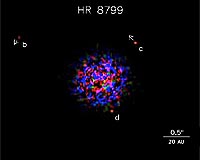| Site Map | Contacts | Links | Newsletter | |
News:
Astronomy
Note: Due to the archiving policies of the various news Websites some links on this page may no longer be valid. All links will take you away from the IBSS Site - use your browser's "back" button to return to this page.
2009
|
 Hints of 'time before Big Bang
Hints of 'time before Big Bang
A team of physicists has claimed that our view of the early Universe may contain the signature of a time before the Big Bang. The discovery comes from studying the cosmic microwave background (CMB), light emitted when the Universe was just 400,000 years old. Their model may help explain why we experience time moving in a straight line from yesterday into tomorrow.
Closest Planetary System Hosts Two Asteroid Belts
Vast Stellar Nursery: Claret-colored Cloud With A Massive Heart
2008
NASA's Phoenix Mars Lander Ready to Gather Samples
06.04.08 -- Two practice rounds of digging and dumping the clumpy soil at the Martian arctic site this week gave scientists and engineers confidence to begin using Phoenix's Robotic Arm to deliver soil samples to instruments on the lander deck. See www.nasa.gov
New TV Series that questions the BIg Bang.
João Magueijo's Big Bang premieres on the Science Channel Tuesday, May 13, at 9 p.m. ET/PT. In this series, Joao Magueijo travels through time and space to explore the six holy grails of modern science.
Watch a preview video clip to see what this renegade physicist is all about.
Stardust Comet Dust Resembles Asteroid Materials
2007
What Happened Before The Big Bang? New discoveries have been made about another universe whose collapse appears to have given birth to the one we live in today. They will be announced in the early on-line edition of the journal Nature Physics on 1 July 2007 and will be published in the August 2007 issue of the journal's print edition. "My paper introduces a new mathematical model that we can use to derive new details about the properties of a quantum state as it travels through the Big Bounce, which replaces the classical idea of a Big Bang as the beginning of our universe," said Martin Bojowald, assistant professor of physics at Penn State. See also Time Before Time ![]() A Big Bounce instead of the Big Bang?
A Big Bounce instead of the Big Bang?

NASA/Johns Hopkins University Applied Physics Laboratory/Carnegie Institution of Washington
January 14, 2008, MESSENGER passed 200 kilometers (124 miles) above the surface of Mercury and snapped the first pictures of a side of Mercury not previously seen by a spacecraft.
NASA's Swift Satellite Images the Triangulum Galaxy Ablaze With Starbirth

Image credit: NASA/Swift Science Team/Stefan Immler.
The image clearly shows the spiral structure of M33. New stars are forming inside the spiral arms. These stars are very hot, and give off a lot of ultraviolet light. This light hits nearby clouds of gas, heating them up and causing them to also shine in ultraviolet light.
Hot Jupiters Wet Too Water vapor confirmed in the atmosphere of a giant extrasolar planet. After the apparent discovery of water on a planet outside our solar system was met with skepticism 3 months ago, an international team of researchers now claims to have found water on a different world using a more powerful method. If the find holds up, it could provide the means of locating the liquid on other alien worlds.
No More Black Holes? A new hypothesis suggests the weirdest objects in the universe don't exist. If new calculations are correct, the universe just got even stranger. Scientists at Case Western Reserve University in Cleveland, Ohio, have constructed mathematical formulas that conclude black holes cannot exist. The findings--if correct--could revolutionize astrophysics and resolve a paradox that has perplexed physicists for 4 decades.
Hubble observes super galaxy formation (October 12, 2006) -- European astronomers say the Hubble Space Telescope is providing the best evidence yet that large massive galaxies form by merging with smaller galaxies.
Hubble Probes Layer-Cake Structure Of Extra Solar Gas Giant Atmosphere Baltimore MD (SPX) Feb 01, 2007
The powerful vision of NASA's Hubble Space Telescope has allowed astronomers to study for the first time the layer-cake structure of the atmosphere of a planet orbiting another star. Hubble discovered a dense upper layer of hot hydrogen gas where the super-hot planet's atmosphere is bleeding off into space. The planet, designated HD 209458b, is unlike any world in our solar system. It orbits so close to its star and gets so hot that its gas is streaming into space, making the planet appear to have a comet-like tail. This new research reveals the layer in the planet's upper atmosphere where the gas becomes so heated it escapes, like steam rising from a boiler.
Dark Stars Dotted Early Universe. Dec. 5, 2007 -- The earliest stars in the universe may have been cool expanses of helium and hydrogen, thick with dark matter and spitting with antimatter. There even may be a few still around.
Endless Universe Made Possible By New Model
Chapel Hill NC (SPX) Feb 01, 2007
A new cosmological model demonstrates the universe can endlessly expand and contract, providing a rival to Big Bang theories and solving a thorny modern physics problem, according to University of North Carolina at Chapel Hill physicists.
Magnetic Explosions In The Distant Universe A new theory to explain the high-energy gamma-ray emissions from collapsing stars has been put forward by an international team of researchers.
NASA Scientists Find Primordial Organic Matter In Meteorite NASA researchers at Johnson Space Center, Houston have found organic materials that formed in the most distant reaches of the early Solar System preserved in a unique meteorite. The study was performed on the Tagish Lake carbonaceous chondrite, a rare type of meteorite that is rich in organic (carbon-bearing) compounds.
SKY-MAP.ORG is an interactive information-management system which encompasses the entire outer space. The basic element of our system is a detailed map of the whole star sky that mirrors more than half a billion celestial objects. No additional instructions are necessary to browse the map or change its scale. The process is very easy. By using the smallest scale, you can view the whole star sky at once. Using the largest scale, you can view tiny areas with the most distant and weakest sky objects. See http://sky-map.org/
HiRISE Releases Thouands Of New Images Of Mars Via New Website Viewer. Anyone connected by Internet can now see planet Mars better than at any time in history, through the eye of HiRISE, the most powerful camera ever to orbit another planet. A University of Arizona-based team that runs the High Resolution Imaging Experiment (HiRISE) camera on NASA's Mars Reconnaissance Orbiter has just released more than 1,200 Mars images to the Planetary Data System, the U.S. space agency's mission data archive. See http://hirise.lpl.arizona.edu/
2006
Hubble finds distant extrasolar planets (October 4, 2006) -- NASA's Hubble space telescope has found 16 extrasolar planet candidates orbiting a variety of distant stars in the central area of the Milky Way.
NASA to save Hubble, to astronomers’ delight
Chandra Independently Determines Hubble Constant Cambridge MA (SPX) Aug 09, 2006 A critically important number that specifies the expansion rate of the Universe, the so-called Hubble constant, has been independently determined using NASA's Chandra X-ray Observatory. This new value matches recent measurements using other methods and extends their validity to greater distances, thus allowing astronomers to probe earlier epochs in the evolution of the Universe.
First Detailed Pictures Of Asteroid Reveal Bizarre System The first detailed images of a binary asteroid system reveal a bizarre world where the highest points on the surface are actually the lowest, and the two asteroids dance in each other's gravitational pull.
Cyclic universe could explain cosmic balancing act. Big bounces may make the Universe able to support stars and life. A bouncing universe that expands and then shrinks every trillion years or so could explain one of the most puzzling problems in cosmology: how we can exist at all.
NASA
Launches Spacecraft To Pluto, The Kuipers And Stars Beyond Washington
DC (SPX) Jan 19, 2006
NASA on Thursday launched a trailblazing probe to Pluto, at the solar system's
outermost limits, after two days of delays.
Stardust Samples
Returning to Earth last weekend after a seven-year, three-billion mile journey
through space, Stardust's Sample Return Canister has now arrived at NASA's
Johnson Space Center, in Houston. In a special laboratory, a team of scientists
at JSC will begin work to open the container and analyze the comet and interstellar
dust samples. An internet webcam is providing live views of the scientists'
work on the canister.
Magellanic
Clouds And Dark Matter Warping The Milky Way
Washington DC (SPX) Jan 10, 2006 - After nearly 50 years, astronomers have
figured out what causes the mysterious and periodic warping of the structure
of the Milky Way galaxy: The Large and Small Magellanic Clouds are interacting
with the galaxy's dark matter halo to magnify their gravitational influence,
creating the warps as they orbit their parent in a cycle that takes about
1.5 billion years.
There
Is More To Starlight Than Meets The Eye Clemson SC (SPX) Jan 06, 2006
Where do elements, such as iron in our blood or calcium in our bones, come
from? Astronomers say they come from thermonuclear reactions in hundreds
of millions of stars that burn at high temperatures in our galaxy.
Integral
Identifies Supernova Rate For Milky Way
Garching, Germany (SPX) Jan 10, 2006 - Using ESA's Integral observatory,
an international team of researchers has been able to confirm the production
of radioactive aluminium (Al 26) in massive stars and supernovae throughout
our galaxy and determine the rate of supernovae - one of its key parameters.
Large Survey Of Galaxies Yields New Findings On Star Formation.
Scientists
Probe Black Hole's Inner Sanctum Cerro Pachon, Chile (SPX) Jan 10, 2006
How does matter spiral its way to the center of a galaxy and into the mouth
of a supermassive black hole? A new study provides the best glimpse yet
at the death spiral of material as it descends into the core of a galaxy
hosting a large black hole.
Ancient Mega Asteroid Dusted Earth.
Martian Snow Source of Tropical Glaciers, Research Team Reports.
Two
New Dusty Planetary Disks May Be Astrophysical Mirrors Of Our Kuiper Belt
Berkeley CA (SPX) Jan 20, 2006
A survey by NASA's Hubble Space Telescope of 22 nearby stars has turned
up two with bright debris disks that appear to be the equivalent of our
own solar system's Kuiper Belt, a ring of icy rocks outside the orbit of
Neptune and the source of short-period comets.
Predicting
The Weather On Titan?
Using recent Cassini, Huygens and Earth-based observations, scientists have
been able to create a computer model which explains the formation of several
types of ethane and methane clouds on Titan.
Public
Tapped to Hunt for Stardust. Jan. 12, 2006
In a new project called Stardust@home, University of California, Berkeley,
researchers will invite Internet users to help them search for grains of
interstellar dust captured by NASA's Stardust spacecraft.

